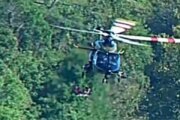Summer is a time for skimpy clothes and exposed skin. But while longer days and warmer weather tend to result in increased activity, efforts to shed extra pounds to look flatter may also lead to weight-loss strategies that detract from performance.
Fortunately, there are ways to correct some common mistakes to keep you going strong.
Too Few Calories
Although it makes sense to eat less if you’re trying to lose weight, do realize that the body requires a certain number of calories for basic functioning, light daily activities and the energy demands of exercise. If you cut your calories too low, you may be too fatigued to hop on the bike, or get out for a walk or run, and may be more likely to burn lean mass than body fat.
So it’s important to create a calorie deficit you can live with. Eating 250 to 300 fewer calories per day could be as easy as taking two to three fewer bites per meal, changing your beverages or reducing the size of your snacks.
[See: 10 Healthy Habits of the ‘Naturally’ Thin.]
Skipping Meals
Surely eating fewer meals per day should result in weight loss, right? The problem is that if you skip meals prior to exercise, your body and brain may be too tired to move, so you end up having a low-quality exercise session or skipping physical activity altogether. The other concern is that skipping meals may make you ravenous later in the day and more likely to overconsume — so instead of eating fewer calories, you may eat more.
Decide on a realistic number of meals to have daily, and try to have the larger meal prior to working out. If you exercise at midday, have a decent-sized breakfast and a mid-morning snack before working out. If you exercise after work, have a substantial breakfast and lunch and maybe a lighter dinner. If you exercise early in the morning, have a third of your breakfast beforehand and the rest after you work out.
Exercising on Empty
Although this may be a viable technique for trained athletes to burn fat earlier on in the exercise session, for the most part, working out on empty may cause physical and mental fatigue, adversely affect concentration and diminish your strength, speed and endurance. And you may be more likely to burn muscle instead of fat.
You don’t have to consume a ton of calories before exercising. If you’re doing cardio, a small banana, or 8 ounces of a smoothie would work. If you are strength training, consider having a 100-calorie serving of Greek yogurt, or an ounce of part-skim mozzarella and a small apple. Aim to eat 30 to 60 minutes before an hour-long exercise session.
Fat and Carb Phobia
For maximum, high-intensity exercise, carbohydrates are the only fuel source for the working muscles. For endurance exercise, the body uses fat and carbohydrates as fuel. So if you minimize your carbs to lose weight, and shy away from fat, this means your body has to use more protein as an energy source during activity. The end result is that you lose lean mass, but keep the body fat, so your body composition changes in an adverse way. Plus, the fat and fiber in carbs provide flavor and make foods more filling.
Be selective with your carbohydrate and fat choices. Fruits and vegetables fill you up, not out, and should be about 40 percent of your plate. Pick higher-fiber whole grains to provide the fill factor. With fats, use them strategically — a drizzle of olive oil on roasted vegetables, or a 100-calorie container of guacamole or a tablespoon of peanut butter on a small apple or celery.
[See: 12 ‘Unhealthy’ Foods With Health Benefits.]
Fluid Faux Pas
It’s never recommended to cut fluids as a way to lose weight. This can make you slower, weaker and more fatigued, increase your risk of injury, contribute to digestive distress, make you more prone to heat-related illnesses and induce headaches. The weight you lose when you limit fluids is only water weight, not fat.
The other problem is failing to recognize that not all fluids are calorie-free. Sports drinks, energy drinks, sweetened tea, large smoothies, some coffee beverages and alcohol can supply upwards of an additional 500 to 1,000 calories daily.
Aim to get more calories from what you chew. Water — plain or flavored with mint and citrus slices — sparkling water, unsweetened tea, vegetable juice, tomato juice and gazpacho can keep you hydrated without adding in a lot of calories. With alcohol, think about the number of drinks you consume and also be aware that the mixers are often the calorie culprits.
Protein Excess
Protein is critically important to maintain lean mass, especially when trying to lose body fat. But if you consume more protein than you need, it will be stored as fat, not muscle. The maximum amount of protein required is 1 gram per pound of body weight — for the weight you want to be.
Keep a log of the protein you consume over the course of a day. Try to divide your protein evenly over the day so you have some at each meal and with each snack. Aim for leaner protein sources, such as lower-fat lunch meats; sirloin cuts of beef or pork; skinless chicken; broiled, baked, grilled or steamed meats; and lower-fat dairy foods, such as milk, cheese and yogurt. This way you maximize protein while minimizing calories.
If you use protein supplements, consider that part of your daily protein intake. So let’s say you require 100 grams of protein a day. If you’re already consuming this amount through your food choices, the additional amount you get in a protein powder is going to be stored as fat. If you do want to use a protein supplement, protein isolates typically have fewer calories. If you want to have a protein bar, check out the calorie count first, and pick a bar with 200 calories. Eat it as a snack in place of, not in addition to, other foods.
Shortchanging Sleep
If you don’t get enough sleep, you may find it harder to lose weight. Getting too little sleep can have an impact on the hormones that affect hunger, making you more likely to overeat and less likely to stop when you’re full. In addition, habits such as overloading on caffeine, eating a large meal in the evening, eating too close to bed and drinking too much fluid at night, especially alcohol, can impair sound sleep.
Try to stop eating about 90 minutes before bed. Make the last thing you eat at night a small snack rather than a large meal, such as a small bowl of cereal; a smoothie with 1/2 cup milk, 1/2 cup frozen fruit and 1/2 cup Greek yogurt; an ounce of cheese with a few crackers; or an apple with a tablespoon of peanut butter and 8 ounces of skim milk. Having protein before bed may help with muscle protein synthesis while you sleep for an added advantage.
[See: The 10 Best Diets for Healthy Eating.]
Weight-loss efforts typically focus on what not to do. However, as you can see from your to-do list, being aware of what, when and how much you can eat will help you achieve your body goals without sacrificing physical performance. So choose well, be consistent and treat your body right.
More from U.S. News
Debunking 5 Common Weight-Loss Myths
15 Best Weight-Loss Diets at a Glance
The 10 Best Exercises You Can Do for the Rest of Your Life
Winning at Weight Loss: How to Cut Fat Without Sacrificing Performance originally appeared on usnews.com







